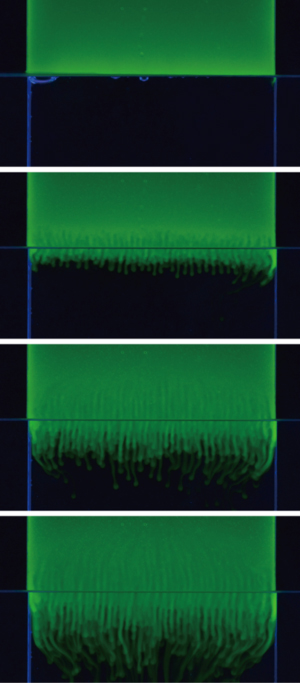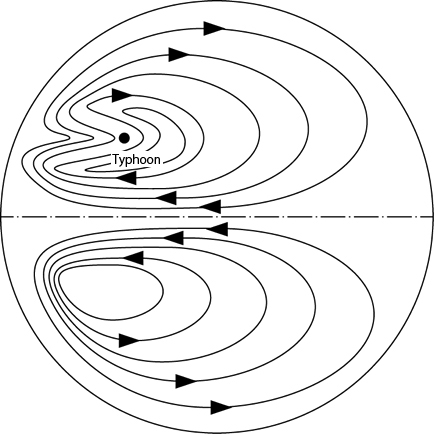Convection Occurs Only the Surface of Sea
The sea on the cubic Earth is inactive, but it does not sit still completely. The seawater evaporates at the surface and becomes salty. The evaporated water forms fog at the high mountains and returns to the ocean as ground water. This cold fresh water penetrates underneath the surface and drives ocean convection. It is confined at the surface and does not penetrate deep sea, though. The thickness of the convection corresponds to that of a paper on a 30-cm cubic Earth.
Wonderful Magic between Layers

Hot salty water is filled on cold fresh water. Tiny salt fingers grow up at the boundary so that the salty water falls down and fresh water invades upper layer. The salty hot water is colored in green. The time interval of the panels is 2 minutes. The side length of the water tank is 10 cm. (Experiment by Naohito Otobe)
The convective layer at the surface can be divided into 2 layers: an upper layer with hot salty water and a lower layer with cold fresh water. Although the water of the upper layer is lighter than the lower layer and the two layers are stably stratified, you will see wonderful water magic at the boundary. As shown in Fig. 9, the salty water falls down from upper layer with a finger like structure following a mushroom like head. The fresh water at the lower layer, on the other hand, grows up like a thin mushroom. This is called salt finger. This is very tiny structure comparing with the whole sea of the cubic Earth, but very important for the ocean convection.
The salt finger can appear in our sea of spherical Earth, but it is very difficult to observe this tiny structure in a vast expanse of ocean. So, the detail remains unknown.
Surface of Sea Flows with Winds

These ocean currents flows only surface of several hundreds meter deep. It is same as our spherical Earth.
Atmospheric wind on the ocean also forces horizontal circulations of the ocean. These circulations occur only in the upper most layer of the ocean. Since the winds blow anticyclonic on the ocean, the ocean currents also flow anticyclonic. In more detail, the ocean currents are intensified at the western parts of the ocean similar to Kuroshio in our real ocean as a result of the rotation of the Earth.
Because a typhoon stays at same position in the north hemisphere of the cubic Earth, the ocean currents around it is twisted a little.



